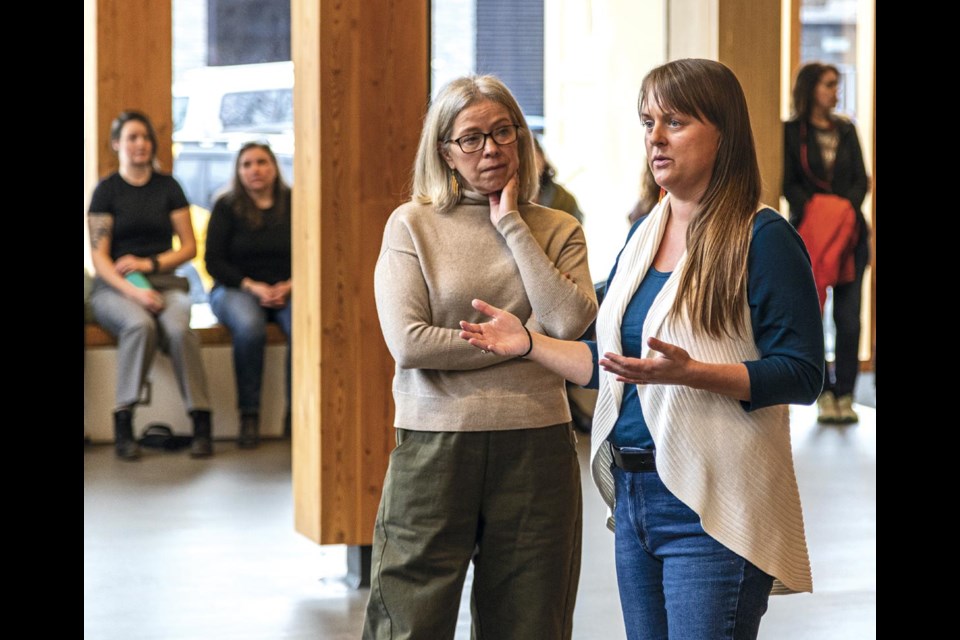The Chilako River Restoration Project is a major undertaking to prevent habitat loss and promote biodiversity in the Chilako River.
The BC salmon population down more than 70 per cent of its long-term average among 41 combinations of regions and species. Major erosion due to flooding in 2018-2020 has resulted in the loss of habitat for salmon and their young, and the Chilako River has seen major losses in the salmon population.
Water, Land and Resource Stewardship Minister Randene Neill toured the project Tuesday, Jan. 14.
“Salmon is so important to our culture," said fishery technician Curtis Seymour. "That is our staple. A long time ago, we survived on salmon ... This population has been decreasing in the last few years due to temperature, the temperatures are too warm. There's no cover around here. So we're trying to bring some protection to the fish, the fry, and trying to make some vegetation so that the sun's not directly hitting the river. This also stabilizes the bank because every time it floods, we lose quite a bit of the bank and the farmers lose quite a bit of ground to the erosion.”
The river has even been reported to be 20 per cent shorter, resulting in shorter runs and less population. As well a loss of vegetation due to this erosion has also majorly impacted the salmon population.
However, the project aims to mitigate the damages and repair the ecosystem all while promoting biodiversity.
The restoration project itself uses the natural environment to great effect.
The crew of 13 workers from Lheidli T’enneh has tied bunches of willow branches to large wooden stakes on the river banks. This provides places for salmon to lay eggs, and newly spawned salmon a place to hide from predators. It also allows the willow branches to grow into the river and its bank come spring and summer, Improving local biodiversity as well as helping to prevent flooding. This is also cost-effective as willow branches are harvested from the surrounding area, and little money needs to be spent on materials.
“I think this is a perfect example of everybody working together.," said Neill. “The community, the First Nation, ranchers, farmers, environmentalists to try to restore and improve the health of the land and the river. Farmers benefit because their fields won't flood every year, and the First Nations benefit because they're bringing back the traditional Chinook that used to spawn in this river. And we're stewarding the land, the way that we're supposed to be stewarding the land. So I think it's a wonderful, amazing success story."
Neill was joined by Chelton van Geloven, director of natural resources and stewardship for Lheidli T'enneh First Nation, and fisheries manager Dominic Frederick.
"There's challenges everywhere," said van Geloven. "You've got to get supplies. Weather's got to line up. Our crew's been amazing, though. It's tricky because, some people want to see it work for 10 years, or some people want to see it work for 20 years before they're going to believe it's going to work. So that's always been a little bit of a strategy. As well as not knowing where the floods are going to be, the unpredictable weather, that's always a challenge."
Van Geloven has been heading up the project and has been instrumental in the project's continued work along the river beds, securing funding, promoting partnerships with industry as well as locals and advocating for the continued support and work being done on the project.
“This project isn't just the Chilaco," said van Geloven “There's a lot of other areas in Lheidli territory that ought to be addressed. It's all part of a salmon recovery strategy ... This is some of the best habitat there is, but it's not functional, and you've just got an eroding bank falling into where you ought to have a pool and a whole bunch of branches and roots in the water.”
Neill said she was inspired by the way multiple organizations and individuals came together to support the project and the restoration itself.
“How everybody is doing this together in a wonderful way, like just even today being here this afternoon," she said. "It's inspiring, and it's the way that we should all be doing this. It's going to benefit all of us in a holistic, beautiful way. So that's wonderful. I think that's what we can all learn from this project.”
Before heading out to the Chilako River site, Neill visited the Wood Innovation and Design Centre in downtown Prince George.



